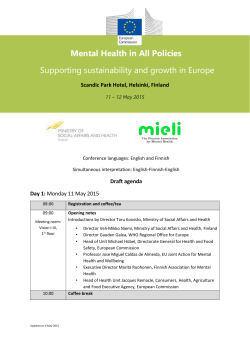
Extreme weather and nuclear power plants (EXWE)
Final seminar Extreme weather and nuclear power plants (EXWE) Kirsti Jylhä, Matti Kämäräinen, Hilkka Pellikka, Milla Johansson, Seppo Saku, Pauli Jokinen, Kimmo Kahma, Ari Venäläinen, Hilppa Gregow Finnish Meteorological Institute Thanks for the whole EXWE research team and the ad hoc group 20 March 2015 Hanasaari Swedish-Finnish Cultural Centre The motivation of the research topic Extreme weather and sea level events may 1) hamper or prevent normal nuclear power plant operation, 2) endanger safe shutdown of a nuclear power plant, or 3) indirectly affect the safety of nuclear power plants e.g. through injuries and damages in the transport sector Very poor visibility due to intense sea-effect snowfall caused severe pile-ups in Helsinki in March 2005 Coastal flood in Sipoo in January 2005 Riku Lumiaro © Esa Nikunen Wind-induced damages in forests: the Helena storm in central Finland in July 2014 Reijo Vesterinen How can EXWE enhance nuclear power plant safety? Regulatory Guides on nuclear safety (YVL): Evaluation of external events triggered by exceptional weather and sea level conditions (YVL B.7, 2013). Estimates of probabilities of weather-related hazards are used as design basis for new power plant units and in the Probabilistic Risk Assessment (PRA) of new and existing NPPs (YVL A.7, 2013). Olkiluoto Loviisa The objective of the EXWE project To provide observational and model-based information about the frequency, intensity, spatial and temporal variation of relevant extreme weather and sea level events and the influence of climate change on them in order to support the safety analysis of nuclear power plants: probabilistic risk assessments and management, plant and system design, adaptation to climate change OUTLINE • Development of methods for studying extreme events • Hot spells • Extreme enthalpy values • Freezing precipitation • Sea-effect snowfall • Sea level rise and coastal flooding risks • Meteotsunamis • Summary Development of methods for studying extreme events Probabilities of rare or even unprecedented extreme weather events – a challenging issue Extreme value analysis of weather observations during the past 50-100 years to provide return levels, with confidence intervals, of very rare events Analysis and downscaling of meteorological reanalysis data and climate model simulations Selecting and testing of criteria and predictors for the identification of hazardous weather cases Longer and more intense hot spells in the future Duration of 31°C exceedance Duration (h) Duration of 27°C exceedance Duration (h) Duration (h) Duration of 23°C exceedance Projected change in hours of the annual maximum duration of spells with air temperature higher than 23°C (left), 27°C (middle) or 31°C at four sites in Finland (from left to right: Vantaa, Jokioinen, Jyväskylä, Sodankylä). • SRES A2 emissions scenario • From bottom to top: the minimum, the 10th, 25th, 50th, 75th and 90th percentiles and the maximum during 30 years. • Red lines: the observed durations in Joensuu on 29 July 2010 Currently very rare enthalpy values to become clearly more common in the future Enthalpy [= f(T, RH, p)] used for design of ventilation and cooling systems Enthalpy index Transient 6 hours 24 hous 7 days 14 days Current (solid line) and projected future (dashed line) return levels of 24-hour enthalpy at four locations as a function of annual probability. Increases of about 10% in the return levels by 2050 The projections are for the period 2035-2064 (around 2050) under the A2 scenario (high emissions of GHGs). Freezing rain: methods To find the freezing rain cases in climate data sets, two main approaches were used: • Inspection of the temporal evolution of the 2-meter temperature during a passage of a warm front • Inspection of the vertical temperature profile Height (m) Temperature (°C) 0°C Time (2 days) Temperature (°C) Changes in larger-scale (synoptic and mesoscale) conditions that favour or can trigger smaller-scale extreme weather Freezing rain: first results 10% More frequent 10% 100 Loviisa 10-7 Olkiluoto 10-2 -10% 0% Less Occurrence of freezing rain in Fennoscandia according frequent to CORDEX regional climate models. Left: Percentage of identified freezing rain days in a year in the present-day climate Right: Estimated relative change in future (%) Hanhikivi 0 Very severe freezing rain, based on the current results, will remain very unlikely at the Finnish NPPs sites, but more research is needed. 10 20 30 40 50 (mm/d) Estimated complementary cumulative distributions of daily precipitation amounts due to freezing rain Sea-effect (coastal) snowfall 3-hour synoptic weather observations, ice extent maps of the Baltic Sea (in SAFIR2018: also radar data) Historical model data (ERA-Interim reanalysis) Regional climate model data Criteria for temperatures at 2 m, surface and 850 hPa, and surface precipitation => predictors of sea-effect snowfall Sea-effect snow in Dec 2009 Sea-effect snow in Feb 2012 Kuva: Vesa Oja/HS Sea-effect (coastal) snowfall Predictors of sea-effect snow applied to gridded historical model data (ERA-Interim reanalysis) => a climatological map about the frequencies of lake-effect snowfall over the Baltic Sea => sea-effect snowfall is • more common over the warmer North Gotland Basin (west of Estonia) • less common over the colder Gulf of Finland and the Gulf of Bothnia. Less sea ice in the future might be expected to cause more opportunities to sea-effect snowing also over Gulf of Finland and the Gulf of Bothnia, but a complex phenomena => more research is needed. 0 3 6 (%) Present-day climatology of occurrence (% of days in a year) of sea-effect snow in the Baltic Sea according to CORDEX regional climate models. Sea level research in EXWE • Extremely high sea levels may endanger the safe operation of a nuclear power plant • It is important to consider changes in flooding risks during the lifetime of the plant • Changes in mean sea level (sea level rise, land uplift, wind climate) • Changes in short-term variation (mainly controlled by weather phenomena: wind and air pressure) >> Combined to yield estimates for exceedance probabilities of high sea levels in the future Coastal floods in Vartiokylänlahti, Helsinki, in January 2005 and December 2011 Photos and info: Jorma Rajala / HKR Sea level research: main findings Sea level rise on the Finnish coast (without land uplift) estimated to be somewhat less (80 %) than the global average. Sea level rise from 2000 to 2100 (without land uplift): estimated upper limit +126 cm in the Gulf of Finland, +122 cm in the Bothnian Sea, +115 cm in the Bothnian Bay. Land uplift counterbalances a significant portion of sea level rise, 40–100 cm in 100 years depending on location. Vestøl et al. West Antarctic ice sheet is the largest source of uncertainty in sea level rise scenarios. Short-term variation has increased: observed annual sea level maxima relative to the mean have increased by 15–30 cm from the 1930s to the present everywhere on the Finnish coast. http://grist.org Mean sea level change from 2000 to 2100 on the Finnish coast, including sea level rise, land uplift and changes in wind climate Worst-case estimates Best estimates Best-case estimates According to the best estimates: increases in the Gulf of Finland, decreases in the Gulf of Bothnia. Meteotsunamis • • Meteotsunamis = meteorological tsunamis, tsunami waves caused by meteorological processes (air–sea interaction) • Appear on the coast as exceptionally rapid and strong sea level variations • Highest known meteotsunamis in the Baltic Sea ~1.5 m high (crest to trough), highest cases worldwide ~6 m high • Several cases observed by eyewitnesses on the Finnish coast 2010– 2011: up to 1 m high Local coastal topography is very important for the amplification of the wave, and extreme oscillations occur only locally • Highest oscillations are restricted to topographically vulnerable places (typically narrow bays and straits) 6-m high meteotsunami In Vela Luka, Croatia in 1978 Meteotsunamis: main findings • None of the Finnish NPP sites is topographically particularly vulnerable to meteotsunamis, but the risk of strong meteotsunamis cannot be excluded for any of them (refraction modelling). • Recent meteotsunami cases in Finland were caused by squall lines and gust fronts propagating over the sea at a resonant speed. • Small meteotsunamis are a surprisingly common phenomenon in the Gulf of Finland: dozens of cases identified in sea level data 1922–2014 (no clear trend in occurrence). 22.4.2015 An example of the refraction model output. Waves arriving from 303° (WNW) produce amplification of wave energy at the Hanhikivi peninsula. 17 8 Aug 2010 Meteotsunami cases identified in archived tide gauge charts 1922–1979 By using observations of air pressure Air pressure data missing or unclear The statistics of meteotsunamies (gathered in SAFIR2014) will be used in SAFIR2018 to estimate the probability of meteotsunami occurrence at the NPP sites. Summary New methods needed to assess probabilities of exceptional or unprecedented extreme weather and sea level phenomena that affect the design principles of the power plants and might pose external threats to the plants. Longer and more intense hot spells in the future. Increases by about 10% in the return levels of the enthalpy indices by 2050. Currently very rare enthalpy values, with an annual probability of 0.001, are expected to become clearly more common. Very severe freezing rain and lake-effect events, based on the current results, will remain very unlikely at the Finnish NPPs sites, but more research is needed. Sea level rise predictions involve large uncertainties and need to be updated regularly. New, improved estimates of sea level rise and future flooding risks on the Finnish coast have been published. Meteotsunamis are much more common on the Finnish coast than has been previously known. They are predominantly small, however, and highest oscillations are restricted to topographically vulnerable places. None of the Finnish NPPs seem to be located in meteotsunami hotspots.
© Copyright 2025





















